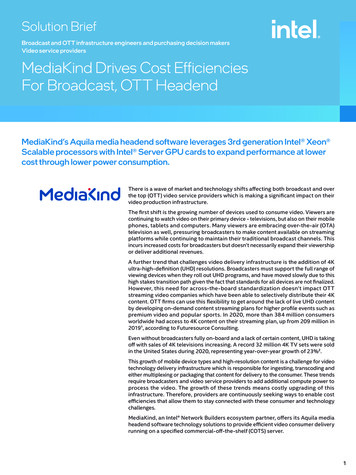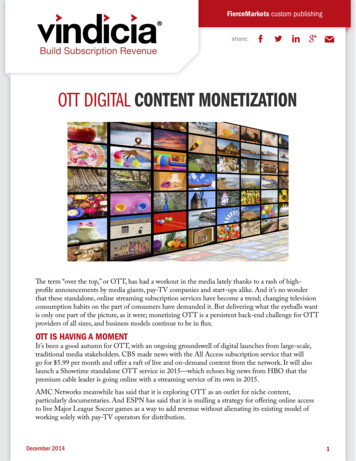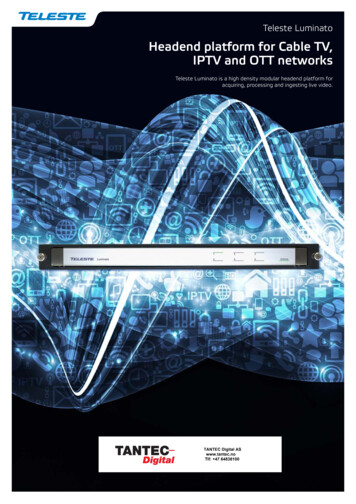
Transcription
Solution BriefBroadcast and OTT infrastructure engineers and purchasing decision makersVideo service providersMediaKind Drives Cost EfficienciesFor Broadcast, OTT HeadendMediaKind’s Aquila media headend software leverages 3rd generation Intel Xeon Scalable processors with Intel Server GPU cards to expand performance at lowercost through lower power consumption.There is a wave of market and technology shifts affecting both broadcast and overthe top (OTT) video service providers which is making a significant impact on theirvideo production infrastructure.The first shift is the growing number of devices used to consume video. Viewers arecontinuing to watch video on their primary device - televisions, but also on their mobilephones, tablets and computers. Many viewers are embracing over-the-air (OTA)television as well, pressuring broadcasters to make content available on streamingplatforms while continuing to maintain their traditional broadcast channels. Thisincurs increased costs for broadcasters but doesn’t necessarily expand their viewershipor deliver additional revenues.A further trend that challenges video delivery infrastructure is the addition of 4Kultra-high-definition (UHD) resolutions. Broadcasters must support the full range ofviewing devices when they roll out UHD programs, and have moved slowly due to thishigh stakes transition path given the fact that standards for all devices are not finalized.However, this need for across-the-board standardization doesn’t impact OTTstreaming video companies which have been able to selectively distribute their 4Kcontent. OTT firms can use this flexibility to get around the lack of live UHD contentby developing on-demand content streaming plans for higher profile events such aspremium video and popular sports. In 2020, more than 384 million consumersworldwide had access to 4K content on their streaming plan, up from 209 million in2019¹, according to Futuresource Consulting.Even without broadcasters fully on-board and a lack of certain content, UHD is takingoff with sales of 4K televisions increasing. A record 32 million 4K TV sets were soldin the United States during 2020, representing year-over-year growth of 23%².This growth of mobile device types and high-resolution content is a challenge for videotechnology delivery infrastructure which is responsible for ingesting, transcoding andeither multiplexing or packaging that content for delivery to the consumer. These trendsrequire broadcasters and video service providers to add additional compute power toprocess the video. The growth of these trends means costly upgrading of thisinfrastructure. Therefore, providers are continuously seeking ways to enable costefficiencies that allow them to stay connected with these consumer and technologychallenges.MediaKind, an Intel Network Builders ecosystem partner, offers its Aquila mediaheadend software technology solutions to provide efficient video consumer deliveryrunning on a specified commercial-off-the-shelf (COTS) server.1
Solution Brief MediaKind Drives Cost Efficiencies For Broadcast, OTT HeadendOn-PremCloudSAASManagement & ControlProduction& PlayoutStat MuxProtectRecord /PackageDRM /OriginEncodeFigure 1. Aquila software workflow.Aquila Software Offers FlexibleVideo HeadendMediaKind’s Aquila software for video headend applicationsincludes video encoding combined with multiplexingtechnology for broadcast applications or packaging forstreaming applications (see Fig. 1). Both solutions ingest anytype of video feed and format and also can dynamically storevideo on physical and / or virtual storage.Both software packages can be integrated with a wide rangeof video codecs supporting MPEG-2, MPEG-4 AVC or HEVCvideo coding standards. The software features MediaKind’sLive Encoding capability that delivers very high video qualityacross multiple codecs. The software enables SD, HD, 1080Por UHD video outputs, including support for high dynamicrange. Both software packages also offer wide audio codecsupport and have universal device format support for allleading segment and manifest formats.Aquila Broadcast and Streamingmedia solutionsMediaKind has developed Aquila using cloud native architecturethat breaks up the software functions into microservicesallowing them to be scaled up or down independently to suitthe needs of delivery operations.Aquila is designed for an environment that values operationalexcellence with high availability, ease of operation, andsimplified maintenance. It has a cloud native architecture whichprovides the freedom to deploy on a COTS server or on anappliance.The live linear broadcast processing capabilities of AquilaBroadcast are designed to deliver high video quality with greatcompression performance, allowing broadcasters to reduce thebit rate needed without impacting picture quality. The solutionalso includes MediaKind’s software-based transport streammultiplexer and scrambler which also helps broadcasters tominimize transmission costs. The software’s complete IPworkflow support includes SMPTE 2022 and SMPTE ST2110.Aquila Streaming is an end-to-end solution for processing anddelivering broadcast-quality video content for OTT and internetprotocol TV (IPTV) networks. The software transcodes,packages, encrypts and delivers both live and recorded contentto consumers. Aquila Streaming also supports digital dynamicad insertion to support services monetization and revenuegeneration.Aquila Streaming delivers market leading compression toenable video bandwidth savings, low end-to-end latency andstorage optimization. This combination delivers all the qualitiesneeded for a premium live video streaming service up to UHD,with the ability to deliver broadcast-quality level experiencesacross all streaming networks.MediaKind G8 Series Server Adds GPUsfor PerformanceThe flexibility built into the Aquila solution software extends toits deployment options, which include dedicated data center orcloud hardware, the public cloud or MediaKind referencehardware. Working with Intel, MediaKind has designed the G8series server with performance, cost, space and power in mind.The G8 series platform combines 3rd generation Intel Xeon Scalable processors with up to two Intel Server GPU cards tooffer both very high throughput and very high cost / densityratio for a low cost per channel.2
Solution Brief MediaKind Drives Cost Efficiencies For Broadcast, OTT HeadendFlexible configuration: 0, 1 or 2 cardsFigure 2. Configuration options for G8 series server.The G8 series is built using the 3rd Gen Intel Xeon Scalableprocessor family with between 8 and 40 cores and a wide rangeof frequency, feature, and power levels. In addition to videotranscoding applications, the CPUs are designed for cloud,enterprise, HPC, network, security, and IoT workloads. Thisprocessor family offers enhanced gen-over-gen performanceand built-in AI acceleration for faster analytics, processing ofmore images or video streams, and more powerful AI in edgeand IoT deployments. Built-in hardware-based security protectscritical code and private data from tampering or interceptionby malware or hackers, a particular challenge in dispersed edge,industrial, or IoT deployments.The G8 series server is a compact 1RU chassis that offers flexibleinput/output interfaces supporting 10 GbE or 25 GbE, 3G-SDIand HD-SDI. With up to 16 HD-SDI interfaces per 1RU chassis,the G8 series is a very high density encoding solution forbroadcast applications.The two slots in the G8 series chassis can each support an IntelServer GPU card. These cards are based on Intel’s Xe-LPmicroarchitecture, Intel’s most energy-efficient graphicsarchitecture, offering a low-power, discrete system-on-chipdesign, with a 128-bit pipeline and 8GB of dedicated onboardlow-power DDR4 memory. Each card includes two Intel ServerGPUs each in a half-height, half-length, PCIe Gen 4.0 add-in card.The cards can feature extensive codec support for MPEG-2, AVC,HEVC, VP9 4K / 8K HEVC 10-BIT.The MediaKind Aquila solutions leverage code optimizationson Intel CPUs to perform the highest quality compression andprocessing for premium content.Building on Success of G8 Series ServerThe current G8 series has been built on the success of the previous MediaKind G8 Series Server, a highperformance video processing server that utilized 2nd generation Intel Xeon Scalable processors. This serverfeatures a compact 1RU chassis that offers flexible configuration options, with IP (up to 25 Gb), 3G-SDI and HD-SDIinput support. With up to 16 HD-SDI interfaces per 1RU chassis, it is the high-density encoding solution forbroadcast applications. For service providers, this advanced server platform still provides significant reduction inoperating expenses when compared to proprietary competing systems.3
Solution Brief MediaKind Drives Cost Efficiencies For Broadcast, OTT HeadendScalability with Lower CostBy using Intel Server GPUs in a system based on 3rd generationIntel Xeon Scalable processors, broadcasters and video serviceproviders can scale graphics capacity separately from the servercount, supporting larger numbers of streams and subscribersper system, at a lower cost (see Table 1).When comparing the performance data for both solutions,MediaKind found that its G8 series with two GPU cards couldoffer the same performance as a multiple server-based solutionfor an average of 30% less cost per channel and average of 40%reduction in power consumption.Before the G8 series, the MediaKind had no support for a GPUcard, so service providers could expand their output channelsonly by adding new servers. But the addition of the GPU cardsin the G8 series expands processing without an equivalentincrease in cost or power consumption and without a need foradditional rack space.The G8 series ser ver can provide dual IP input/outputmanagement, IPMI remote management support and hotswappable power supplies, all of which contribute to highservice uptime and superior delivery.POWERCONSUMPTIONIN WATTSCOST REDUCTIONPERCENTAGE(COMPARED TOSTANDALONE G8)POWER REDUCTIONPERCENTAGE(COMPARED TOSTANDALONE G8)SYSTEMCONFIGURATIONPROCESSORG8 series serverDual Intel Xeon Scalable6240R processors28 196,0001540000G8 Series Serverwith dual GPUcardsDual Intel Xeon Scalable6240R processors Intel Server GPU card16 132,8009760-32%-37%G8 Series Serverwith four GPUcardsDual Intel Xeon Scalable6240R processors quadIntel Server GPU cards11 105,6007370-46%-52%NUMBER OFSERVERSCOSTTable 1. G8 series server options required to provide a system capable of supporting 80 channels of HD OTT channels and 80HD IPTV channels. Testing was conducted by MediaKind in it’s labs in April of 2022.
Solution Brief MediaKind Drives Cost Efficiencies For Broadcast, OTT HeadendConclusionResourcesAquila software has been helping broadcasters deliver videocontent for decades and has been awarded a Technical Emmyfor its high quality. Broadcasters and OTT players demand thehighest video quality, but also need their consumer deliveryplatforms to support viewers and subscribers that areconsuming video in new ways and at higher video resolutions.MediaKind Aquila SoftwareBy utilizing 3rd generation Intel Xeon Scalable processorscombined with Intel Server GPU cards, the G8 Series Server canprovide a flexible compute platform. With the G8 series,broadcaster and OTT video providers have the performanceand flexibility they need to manage a new video consumptionlandscape.MediaKind G8 seriesIntel Network Builders ecosystem3rd generation Intel Xeon Scalable processorsIntel Server GPUWith the availability of the G8 series, MediaKind has a platformfor its Aquila Broadcast and Aquila Streaming software solutionsthat enable significant channel scalability and cost efficiencieswithin the same form factor combined with minimal increasesin power consumption.Notices & Disclaimers¹ on-of-perception/7647.article² on-of-perception/7647.articleIntel technologies may require enabled hardware, software or service activation.No product or component can be absolutely secure.Your costs and results may vary. Intel Corporation. Intel, the Intel logo, and other Intel marks are trademarks of Intel Corporation or its subsidiaries. Other names and brands may be claimed as the property of others.0622/TM/HO9/PDFPlease Recycle350394-001US5
video production infrastructure. The first shift is the growing number of devices used to consume video. Viewers are . bit rate needed without impacting picture quality. The solution . The cards can feature extensive codec support for MPEG-2, AVC, HEVC, VP9 4K / 8K HEVC 10-BIT. .









